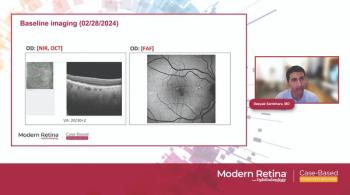
SHRM characteristics impact visual acuity in wet AMD
Subretinal hyperreflective material (SHRM) is a morphologic component seen on optical coherence tomography (OCT) images as hyperreflective material that is external to the retina and internal to the retinal pigment epithelium (RPE), said Jaya B. Kumar, MD.
Subretinal hyperreflective material (SHRM) is a morphologic component seen on optical coherence tomography (OCT) images as hyperreflective material that is external to the retina and internal to the retinal pigment epithelium (RPE), said Jaya B. Kumar, MD.
SHRM has a detrimental effect on vision in eyes with neovascular age-related macular degeneration (nAMD), said Dr. Kumar, a vitreoretinal fellow at Cleveland Clinic, Cleveland.
Investigators found that SHRM that was taller, had a layered appearance, increased reflectivity, and larger size were associated with worse visual acuity at the 12- and 24-week follow-up examinations.
Dr. Kumar and colleagues have reported previously that larger SHRM is associated with poor visual outcomes and the lesion size does decrease with treatment.
“Many researchers have postulated that SHRM is comprised of scar tissue, fluid, and perhaps hemorrhage, but morphologic data about SHRM are limited as is knowledge about its effect on visual acuity,” Dr. Kumar said.
She and her associates evaluated the association of the SHRM morphologic features with the visual acuity in eyes with nAMD in a retrospective study of 170 patients who were participants in randomized anti-vascular endothelial growth factor (VEGF) and anti-platelet-derived growth factors (PDGF) trials of patients with nAMD who were treatment-naïve.
Five monthly ranibizumab (Lucentis, Genentech) injections were administered to all patients with or without anti-PDGF treatment. All patients had SHRM and underwent spectral-domain OCT at baseline and 3 and 6 months.
The images were evaluated by masked readers for morphologic changes in the shape, defined as tall, that is, dome-shaped and a minimum of 120 μm at the foveal center; flat and under 80 μm at the highest point in the foveal center and appeared to have a thin disc appearance; or dysmorphic with an unusual shape based on the underlying pigment epithelial detachment, Dr. Kumar explained.
“We found that SHRM that was taller at baseline had significantly worse visual acuity at 3 and 6 months,” she said. “No correlations were seen regarding SHRM that was flat or dysmorphic.”
Investigators also evaluated the SHRM boundaries, which they described as well-defined anterior and posterior boundaries in at least 75% of the lesion within the foveal center; poorly defined as the inability to highlight the lesion outline at least in 25% of the lesion; or mixed if about half of the lesion could be defined. No significant correlations between the demarcations of the anterior and posterior boundaries were seen with the visual acuity during follow-up, she pointed out.
The presence of any space above or below the SHRM lesions also was considered.
“Between the SHRM and the RPE, if there was space along the SHRM, the visual acuity was better at 3 and 6 months,” Dr. Kumar said. “However, if the space was between the outer retina and the SHRM, the visual acuity was worse at 3 and 6 months.”
The reflectivity of the SHRM lesions was categorized two ways: one, as being as hyperreflective as the outer plexiform layer and as hyperreflective as the RPE, and two, as in-between.
“We found that more hyperreflective lesions on presentation were correlated with worse vision during follow-up,” she said. “However, over time as the vision became less hyperreflective, the visual acuity was better at 3 and 6 months.”
Distinct hyperreflective bands were observed in the SHRM lesions, which the investigators referred to as having a layered appearance. They found that as the layering progressed over time, the lesion became more consolidated and more hyperreflective.
“If these bands were present at baseline, this was associated with worse visual acuity at 3 and 6 months,” she explained.
Hyperreflective spots were defined as the presence of at least three to five spots, each at least 20 μm in size, seen on the OCT slices in the foveal center.
“On presentation, if the spots were present, the patients tended to have worse visual acuity on follow-up,” Dr. Kumar said. “If the spots persisted during follow-up, the visual acuity outcome was significantly worse at the corresponding visits.”
The maximal height, width, and area of the SHRM lesions were determined in the foveal center, 1 mm2 around the fovea, and in the entire macula.
“The larger the lesion at each of these sites, the worse the visual outcome was at presentation and 12 and 24 weeks,” she said. “If the lesions became small, the vision improved significantly.”
New findings wrap-up
This study identified some new findings. The investigators hypothesized that the large barrier created between the retina and pigment epithelium disrupts the photoreceptor function.
They also found that as the SHRM lesions disappeared, the vision improved.
In addition, with greater lesion hyperreflectivity, the vision became worse. The thought is that as anti-VEGF therapy dries the lesion, a dense necrotic scar is left that is hard to resolve.
“Characterizing SHRM can provide practitioners with better vision and anatomic prognoses,” Dr. Kumar concluded.
Dr. Kumar has no financial interest in any aspect of this report. She reported her study results at the 2017 meeting of the American Society of Retina Specialists in Boston.
Newsletter
Keep your retina practice on the forefront—subscribe for expert analysis and emerging trends in retinal disease management.








































